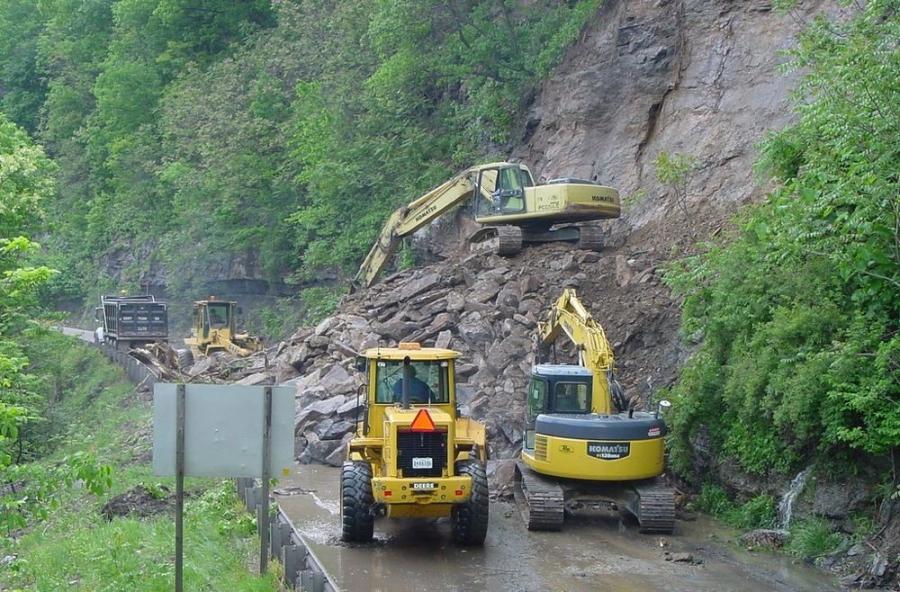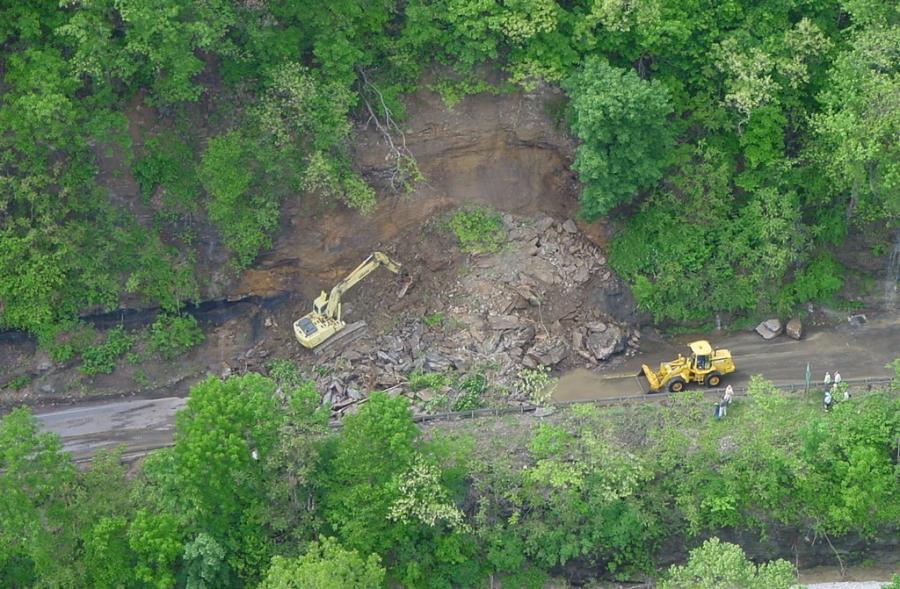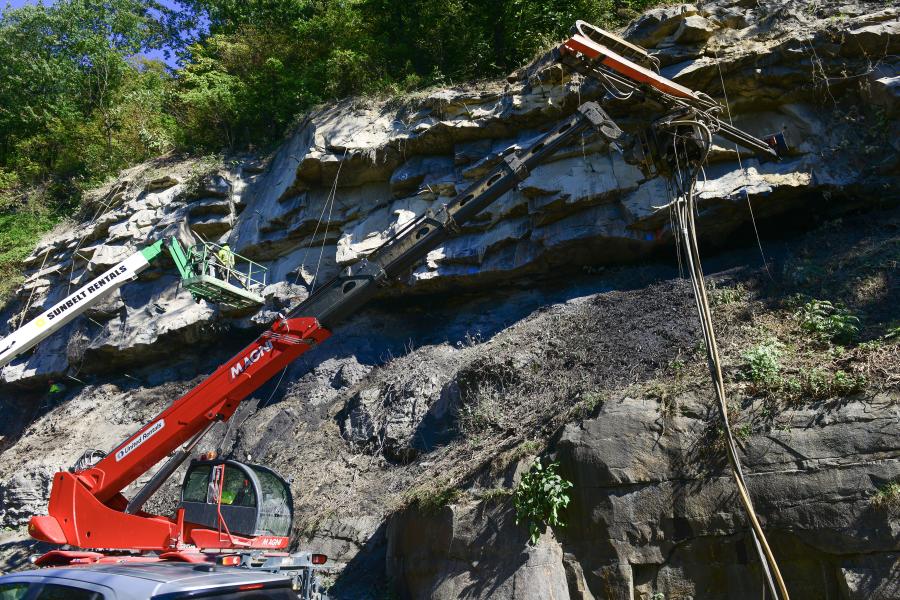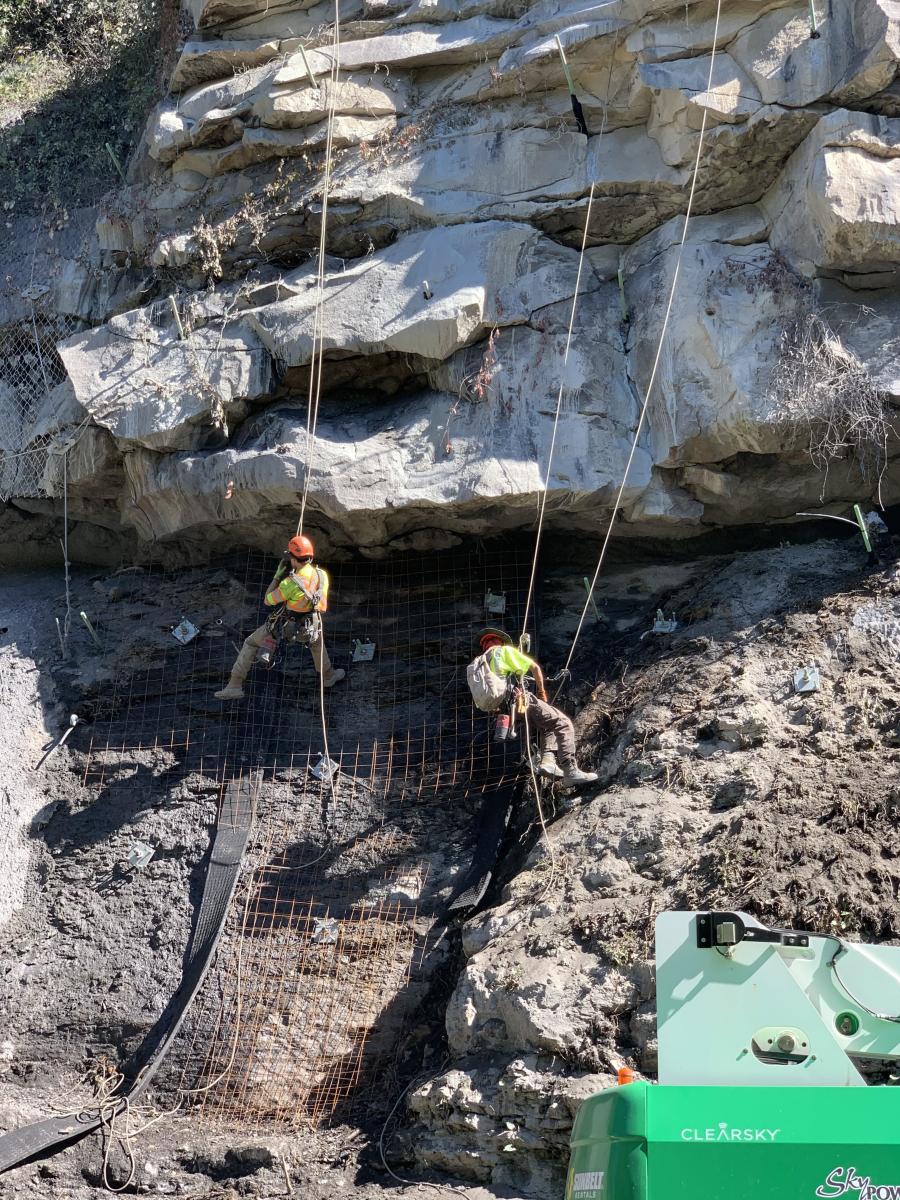Triton Construction Inc. performed all Class 1 excavation, E&S Controls and trench drains.
A slope stabilization project is running well ahead of schedule in Allegany County, Md.
The Maryland Department of Transportation's State Highway Administration (SHA) initiated the work in response to repeated rockslides along the roadway.
The project, MD 135 Slope Protection, involves six locations from the Garrett County line to U.S. 220 McMullan Highway in Allegany County. This covers approximately 3 mi. The stabilization of the bank will keep rocks and debris from entering the roadway, increasing the safety of traveling motorists.
The prime contractor is Triton Construction Inc., of St. Albans, W. Va., with Justin Koers as the lead.
The total dollar amount is $3.6 million. Work began in April 2021 and the projected completion date is June 2022. However, the project is expected to be finished months in advance.
MD 135 was built in the early 1930s as a link between McCoole and Westernport. In the late 1930s, the highway was extended west to Bloomington.
The project consists of six different slope failure sites that were considered high risk for future failures. They are located in Luke, Westernport and Bloomington. There are a total of 20 sites that have been identified in that corridor.
The area is located along a steep embankment with no access road from the top. To have access to the areas that need to be addressed, MDOT has partnered with Access Limited Inc., a contractor that uses an access method that focuses on rappelling to the sites that need to be marked, drilled and grouted. This has allowed them to reach the steep areas along the embankment. Crews will tie off at the top and rappel to the locations that need drilled or marked and do the work while harnessed in.
Section 7 has been completed. More than 4,000 cu. yds. of soil and rock were removed from this site and it was stabilized with turf grass establishment and covered with matting.
Section 9 also is complete. Trench drains were created emptying into a rock buttress at the bottom of the embankment.
Sections 14, 16 and 18 are complete. Debris was removed, then 10-ft. soil nails were installed and grouted in place. Some areas had shotcrete applied and steel wire mesh netting put into place.
In Section 2, underbrush has been removed and scaling completed. Other work includes drilling and installing 20-ft. rock dowels, installing steel wire mesh netting and applying shotcrete.
The full scope of the project includes maintenance of traffic, Class 1 excavation, rockslide prevention devices and erosion and sediment control.
"The history of slides goes way back," said Devin Miller, assistant engineer of construction of MDOT District 6. "One of the studies actually showed that there was 22 cubic yards of debris that was anticipated to be able to fall, which is a huge amount. It doesn't come out in a processed form. Some rocks come down and some material, but it's not processed. Some you have to break up to be able to move to haul. It's not apples to apples, the form in which it hits the street — some of it is the size of a table or bigger."
Shelley Miller, District 6 community liaison, noted that the work is being done in a tight area with steep slopes that are rocky. There also are railroad lines and a river, so there are not many options for moving the road.
Devin Miller reported that records of slides date back to the 1960s. At times, the road was closed between 8 and 12 hours to haul material out and get the road open.
"We would clean up and then try to prevent it for next time," he said. "It was reactive. We did have to have an emergency contract for one section that cost about $3 million. When you're under the gun, everything costs more."
In the current project, six sites will be completed for $3.6 million, including engineering and construction.
"The option isn't anything but what we did and what we did was great," Miller said. "We just had six inches of rain. Our staff was there 24 hours all the way around. We did not have one thing in the road — nothing. What we did is not a permanent fix. It's a very, very good fix and it's eliminated the catastrophic failures, but I caution everybody that there could be another six- or 10-inch storm that a piece of that slope would slough. Because we're dealing with mother nature and shy of removing the issue, there is no fix. This is all really, really good stuff and the stuff we did back on the previous fixes are all still there and they're working fine. But the geologists and the designers will come to you and tell you that this is our best design we can do given what we have."
Shelly Miller said that safety is always the number-one priority.
"We hate to inconvenience motorists by having roads closed, but we hate it even more for somebody to be injured or killed," she said. "These slides have the significance of being able to do far more damage than closing a road."
Dan McKenzie, area engineering of MDOT, said a combination of different techniques are used depending on the soil on the hillside, which includes shale and coal seams.
"There is no cookie-cutter design for it, even when it's designed on paper," Devin Miller said. "This stuff is very fluid as far as the work. The contractors that were associated with this were top-notch."
Shelley Miller noted that a study was done in 2008 that identified 20 sites that were the most at risk.
"Then out of those 20, they looked at this as a Phase 1 and which of those are the top most likely to fail," she said. "These six were the ones they came up with — the ones of most concern."
She noted that Access Limited is able to save time on the project because it has a team of people who can rappel down the site rather than having to work with a lift that must be moved
"They're very talented, very skilled, very experienced, which is of course what you are looking for," she said.
Craig Diehl, project engineer, noted that one of the most challenging aspects is getting the workers up on top of the slope and coming down with the rope.
"They had to scale all the loose material with little picks so that it wouldn't fall down on everybody," he said. "They spent about four days up there just scaling all the loose material down before we brought anything in here to start with."
He said that this is the first time he's worked with Access Limited.
"I'm impressed with them," he said. "Definitely, we're ahead of schedule. They're proactive, especially with a lot of safety issues. I do enjoy that part in working with them instead of trying to do stuff behind your back to get it done and get out of here. They want this to be a lifetime job where everything's good on it."
Evan Langenbach is Access Limited's superintendent. On this job, he serves as supervisor, watching over the drilling, mesh placement and climate.
"(I'm) making sure everybody stays safe, everybody goes home at night with all their digits, all their fingers, all their limbs," he said. "My guys tend to stay pretty safe." But he added, "It's not an old man's game."
He said that one of the most difficult aspects of this particular job is probably the drilling, because of the hard material.
"I'm told its ancient sandstone," Langenbach said.
He explained that the company is based in California, but travels all over. At a lot of jobs, the elevation is such that cranes can't be taken in, so materials are flown in by helicopter.
Triton Construction Inc. performed all Class 1 excavation, E&S Controls and trench drains.
Subcontractors are Access Limited, for all slope protection, wire mesh, shotcrete, soil nails and rock dowels and the "U" Company, for all turfgrass establishment and soil stabilization matting.
The equipment list includes two Komatsu PC 90 trackhoes, a Cat 317 GC trackhoe, a Cat D5 dozer, a Cat 944 loader and a Magni TH 6.20 telehandler with drill attached.
Approximate materials include 300 rock dowels, 4,100 sq. yds. steel wire mesh, 8,000 cu. yds. Class 1 excavation, 200 cu. yds. shotcrete, and 5000 sq. yds. turfgrass establishment. CEG
Brenda Ruggiero
Brenda Ruggiero has written for CEG for over 20 years. She lives near the town of Accident in far western Maryland. Her favorite assignments so far involved interviews with Survivor’s Boston Rob and hot dog eating champion Joey Chestnut. Both were involved in construction at one time.
Brenda holds a BA in Mass Communication with a writing focus from Frostburg State University and minors in Public Relations and Political Science. She works full time as a staff writer for a weekly newspaper, the Garrett County Republican. She enjoys feature writing the most, which gives her the opportunity to talk to people and share their stories.
Brenda and her middle school sweetheart, Reuben, have been married for over 34 years and have three grown children and four cats.
Read more from Brenda Ruggiero here.
Today's top stories

















